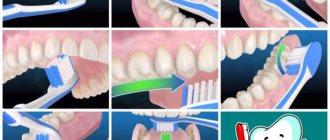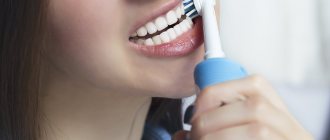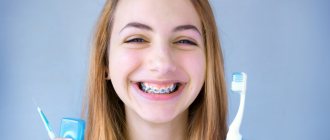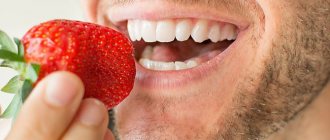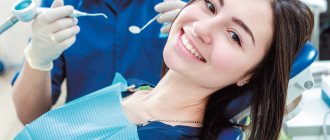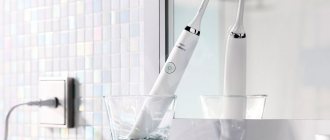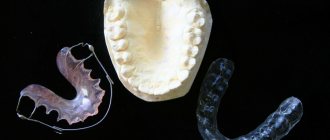The health of the dentition and gum tissue depends on many factors, the key of which is the quality of hygiene procedures.
Regular removal of bacterial plaque and food residues allows you to maintain the natural microflora of the oral cavity and prevents the development and proliferation of pathogenic microorganisms.
At the same time, hygiene procedures must be not only timely, but also correct, and for this it is important to understand exactly how each of the devices intended for cleaning the dental surface should be used.
Using a classic toothbrush
Cleaning with a manual brush should be carried out at least twice a day - in the morning and in the evening (before bedtime). The recommended duration for processing a row using this device is 3-4 minutes.
Scheme for cleaning the upper and lower dentition with a classic toothbrush
Proper cleaning with a classic brush involves the following steps:
- A pea of paste is applied to a brush moistened with water.
- Cleaning begins from the upper jaw. You need to start with the front teeth, gradually moving towards the molars.
- Movements to remove plaque should be sweeping and directed from the gum line to the cutting surface.
- To clean the cutting surface of the teeth, the brush is positioned perpendicular to it, after which circular movements are performed.
- After performing manipulations with the upper row, the same procedure is repeated with the elements of the lower jaw.
- To complete the hygiene procedures, it is necessary to clean the tongue using bristles or the back of the brush head if it is equipped with a rubber grooved surface.
After thoroughly removing plaque with a brush, you can rinse your mouth with a special rinse, which not only helps improve the condition of your teeth and gums, but also ensures fresh breath for a long time.
The video provides a detailed description of using a toothbrush.
What is a wedge-shaped tooth defect and the reasons for its development. Read here all the most interesting things about decorating teeth with rhinestones.
At this address https://dr-zubov.ru/ortopediya/semnye-protezy/kak-osushhestvlyaetsya-remont.html we will tell you whether it is possible to repair a removable denture.
How to choose toothpaste?
Stay up to date! There is a wide variety of toothpastes with different beneficial and healing effects.
To choose the right quality product, you need to know exactly what problems it should solve.
There are four main groups of toothpastes, each of which has its own characteristics.
Types of toothpaste:
- Hygienic cleaning pastes. The product of this group is intended to remove food debris, plaque, and also to freshen the oral cavity. This paste does not contain active components that are designed to protect the enamel from caries and other problems. Therefore, they are recommended for absolutely healthy people without any dental problems.
- Therapeutic and prophylactic toothpastes . They not only cleanse teeth of plaque, but also protect the entire oral cavity from caries, periodontitis, gum inflammation, destruction of tooth enamel and other problems. There are also medicinal pastes that are designed to help treat existing diseases.
- Whitening toothpastes lighten the enamel. They help make your enamel whiter and your smile more beautiful. But the whitening components contained in such toothpastes have a negative effect on tooth enamel. Their use is often not recommended.
It is worth noting that dentists recommend using several types of pastes at once, alternating them . For example, therapeutic and preventive.
When choosing an oral paste, you should pay attention to the product that contains the largest amount of natural ingredients.
Remember! It is better to avoid pastes that contain sodium lauryl sulfate, it is used as a foaming component. It may cause allergies in some people.
Sodium lauryl sulfate enters the body through the mucous membrane and, accumulating over years, can cause not only allergies, but also decreased vision, memory, and cancer.
When choosing a toothpaste, it is better to avoid the following ingredients:
- Parabens;
- Coarse abrasives;
- sodium lauryl sulfate;
- Synthetic dyes;
- Fluorine;
- Triclosan.
Fluoride toothpastes have always been considered beneficial and effective against tooth decay. However, fluorine for pastes is taken from nuclear waste.
Need to know! It has a negative effect on the body, affecting brain function, reducing immunity and accelerating the aging process of the body.
Parabens are often found in toothpastes. They are used to extend the shelf life of the product.
However, these substances cause hormonal disorders, as well as cancer in women.
Electrical devices
The technology of brushing teeth with an electric brush is slightly different from the manipulations carried out with a classic device.
This is due to the absence of the need to exert additional force, since the brush head makes pulsating and rotating movements, removing plaque.
Manufacturers of electric brushes include the following instructions for use with their products:
- The brush head is moistened with water, after which a small ball of paste is applied to it.
- The brush is placed near the front teeth parallel to the jaw line, after which the power button is pressed.
- The duration of cleaning one unit should not exceed 4-5 seconds. In this case, you should not apply pressure or make horizontal or circular movements.
- Moving from the central incisors to the molars, the front surface of all elements of the upper and lower jaw is cleaned.
- To remove plaque from the lingual and cutting parts of the row, the brush is positioned vertically, after which the procedure is repeated.
After completing the process of brushing your teeth, the same procedure is carried out with your gums, however, this is permissible in the absence of inflammatory processes in them.
Watch the video for instructions on brushing your teeth with an electric brush.
Cleaners
Brushes for cleaning teeth are used as an additional device for oral hygiene.
A properly selected product helps remove plaque from hard-to-reach areas of the jaw, for example, the interdental space.
To remove bacterial plaque using a brush, you must perform the following sequence of actions:
- The brush is brought to the space between the molars and carefully inserted into it at an angle of 90 degrees until the tip of the product appears from the inside.
- Several careful back-and-forth movements are performed in the interdental space.
- The brush is removed from the treated slot and washed under running water.
- The manipulation is repeated with each element of the upper and lower jaw rows.
When using a brush, it is important to understand that its insertion should not cause pain or discomfort.
Otherwise, you should contact your dentist for advice and help in choosing the appropriate size of the device.
In the video, watch the cleaning technique with a brush.
Irrigator
The use of an irrigator allows you to efficiently remove plaque from the gum pockets and interdental space, even with maximum crowding of incisors and molars.
To do this, you must follow the sequence of actions:
- An individual nozzle is installed in a special connector of the irrigator.
- The reservoir is filled with water at a temperature comfortable for the oral cavity or with a special rinse aid.
- If the device has several operating modes, the most suitable one is selected, taking into account the condition of the oral cavity.
- Teeth cleaning begins with the far molars. The device is positioned in the oral cavity so that the nozzle is directed at a right angle to the tooth, after which the power button is pressed.
- The space is treated in the following sequence: first the interdental space, then the gum line, then the rest of the molar. This manipulation is repeated with all elements of both jaws.
- After finishing using the irrigator, it must be turned off and the reservoir must be rinsed if a mouth rinse solution was poured into it.
Do not forget that while using the irrigator, water will flow out of the oral cavity, so the procedure must be performed in front of the sink.
Find out how to use the irrigator from the video.
Teeth whitening technique with activated carbon and effective recipes. Learn about the symptoms of oral cancer in this article.
Follow the link https://dr-zubov.ru/lechenie/bolezni-polosti-rta/gel-kamistad-instrukciya-po-primeneniyu.html if you are interested in instructions for using Kamistad ointment.
Ionic devices
The operating principle of the ionic brush is based not only on mechanical action, but also on changing the polarity of the teeth, due to which plaque is more effectively separated from the enamel.
The technology for cleaning the jaw row using this product is as follows:
- The hygienic procedure begins with the removal of plaque located on the surface of the tongue. Using gentle massage movements, you need to move from its base to the tip.
- The same delicate movements remove plaque from the gums and mucous membrane of the cheeks.
- Next, the brush is thoroughly rinsed under running water, after which a small amount of paste is applied to it.
- The procedure for cleaning the teeth is no different from those manipulations that are usually carried out when using a manual brush, with the difference that the intensity of movements may be lower.
To increase the effectiveness of using the brush, approximately once a month it is necessary to remove the attachment and clean the metal core.
In the video, a specialist explains how to use ionic toothbrushes correctly.
How to save teeth
Maintaining dental health is a complex process. It is not enough to know how to brush your teeth correctly and use additional “care” accessories - it is important to promptly follow the doctor’s recommendations and follow preventive measures.
Vitamins for teeth
To strengthen and maintain healthy teeth, the body requires sufficient amounts of certain vitamins and microelements. They can be obtained both from food and taken in the form of supplements.
- Calcium. Participates in the formation of tooth enamel. According to statistics, 99% of calcium in our body is concentrated in bones and teeth. Lack of calcium causes tooth and enamel destruction.
- Phosphorus. Necessary for the formation of insoluble salts that strengthen teeth and for the formation of strong enamel.
- Vitamin D. Improves the absorption of calcium and fluoride. A lack of vitamin D causes dry mucous membranes, leaching of calcium, which leads to tooth decay.
- Vitamin C. A lack of vitamin C causes bleeding gums, and severe deficiency leads to scurvy.
- Vitamin A. Ensures dental health and strengthens the immune system. Vitamin deficiency provokes sore gums, increases the risk of developing periodontitis, and causes discoloration of the enamel.
To choose the optimal vitamin complex for your teeth, consult your dentist. The doctor will recommend a vitamin complex based on the condition of the teeth and oral cavity, and advise when and how best to take it.
Microelements necessary for dental health can be obtained both from food and taken in the form of supplements.
Products for strong teeth
Proper nutrition is an important step towards healthy and beautiful teeth.
- Products with a high calcium content - fish, walnuts, dried apricots, raisins, green vegetables: lettuce, beans and cabbage. You need to be careful with dairy products: only dairy products without sugar or with low sugar content (milk, cottage cheese, kefir, etc.) are healthy.
- Sweet milkshakes, cheese curds and other dairy desserts, due to their high sugar content, will do more harm than good.
- Cheese. It increases the amount of calcium in tooth enamel by 60% and increases the volume of saliva, which contains components that prevent the development of caries.
- Buckwheat, sea fish, green salad and boiled potatoes are irreplaceable sources of fluoride.
- Citrus fruits and apples are foods high in vitamin C. Citrus fruits reduce the risk of gum inflammation, and lime additionally contains organic acids to naturally whiten enamel.
- Hard vegetables and fruits: carrots, apples, cucumbers. They normalize blood circulation in the gums and provide vitamins and microelements necessary for dental health. In addition, due to its rigid structure, it provides natural massage to the gums and cleanses the teeth from plaque.
Proper nutrition is an important step towards healthy and beautiful teeth.
Procedures to strengthen teeth
To strengthen teeth, it is recommended to regularly carry out professional oral hygiene, which includes several steps to clean and strengthen teeth. Cleansing and strengthening procedures include:
- Ultrasonic teeth cleaning is a method of gentle and safe professional cleaning that removes plaque and tartar using an ultrasonic scaler. Due to sound vibrations, the device removes all deposits, restoring the enamel's strength and natural color.
- AirFlow is a plaque removal procedure using a mixture of water and abrasive particles delivered under high pressure. This procedure is most often recommended for people prone to plaque formation: for example, smokers and coffee lovers.
- Teeth polishing. Aimed at eliminating irregularities on the tooth surface to reduce the risk of enamel destruction and bacterial penetration.
- Remineralization is a complex procedure for restoring the mineralogical composition of enamel. During remineralization, various pastes, rinses, gels and other products with a high content of calcium and fluoride are used.
- Fluoridation is a method aimed at strengthening enamel and saturating it with fluoride. Fluoridation is divided into simple and deep. With simple fluoridation, the doctor attaches pads with a gel containing fluoride. With deep fluoridation, deep cleaning is first carried out, and then a substance with a large amount of fluoride is applied to the tooth.
Strengthening procedures are selected only by a specialist. You cannot carry out fluoridation, remineralization and other procedures on your own - this will lead to the destruction of the enamel and can cause damage to the tooth.
Experts recommend regular professional oral hygiene
Mono-beam products
A mono-beam brush can be used not only by users of orthodontic structures, but also by everyone for the daily removal of plaque from the elements of the jaw row and gum pockets.
In order for the device to bring maximum benefit, when using it, you must adhere to the following sequence of operations:
- The head of the product is moistened with water, after which it is positioned at an angle of 45 degrees relative to the surface to be processed. It is advisable to start with the outermost molars, moving towards the central incisors.
- First, you need to clean the gum line, then treat the periodontal pocket and the remaining surface of the tooth, moving from the base to the cutting part. Movements should be sweeping or circular.
- After cleaning the front part of the tooth, the lingual part, the cutting surface and the space between adjacent molars are treated in the same way.
- The manipulations are repeated with each element of the jaw row. The duration of treatment of one tooth should not be less than 10 seconds.
The technique of cleaning with a mono-beam brush is presented in the video.
Flosses
Dental floss allows you to remove plaque and the smallest food debris from the minimal interdental space, which cannot be penetrated with a brush.
To achieve maximum results and prevent gum injury, you should follow these recommendations:
- With thoroughly washed and dried hands, remove about 30 cm of thread from the container and cut it using the built-in knife.
- The floss is wound around the index fingers of both hands so that the length of its free part does not exceed 5 cm.
- A section of floss formed between the fingers is inserted into the interdental space up to the gum line and gently lowered into the pocket, surrounding the neck of the tooth.
- With smooth sweeping movements, plaque is removed from under the gums, after which the thread is lifted with longitudinal movements to the cutting part.
- The used piece of thread is replaced with a new one, after which the manipulations are repeated in the next interdental space.
When flossing, it is important to use smooth movements to avoid accidental injury to the gum tissue.
Watch the video on how to use interdental floss.
Improper brushing of teeth
Let's admit it, we brush our teeth automatically. And we often do it wrong: we clean them with movements left and right, sherk-sherk. With this method of cleaning, soft plaque is transferred from the surface of the teeth to the interdental spaces and becomes clogged there. As a result, there is a danger of gum damage and the appearance of a wedge-shaped defect, especially on protruding teeth. A wedge-shaped defect is a lesion of a tooth in the area of contact with the gum. It looks like a step that resembles a wedge. The dimensions can range from barely noticeable to complete chipping in the future.
See what happens when we brush our teeth across their growth:
Secrets of caring for braces
In order to efficiently clean the teeth and the space between the elements of the orthodontic structure, dentists recommend using not a regular brush, but a product with a V-shaped bristle or a mono-tuft model.
The procedure for removing plaque is also slightly different from regular cleaning:
- The brush is positioned at an angle of 45 degrees relative to the front surface of the tooth.
- With the help of forward and backward movements and slight pressure on the brush, the enamel is cleaned of the plaque covering it, both from the outside and from the inside.
- To clean the bracket, you need to perform a few light movements from the gum line to the cutting surface of the tooth and in the opposite direction. Strong pressure should be avoided to avoid damaging the locks.
- The cutting surface is cleaned by placing the brush perpendicular to the axis of the jaw row elements. Circular movements of the bristles, combined with slight pressure, will qualitatively remove small particles of food and pathogenic microflora.
To effectively remove plaque, dentists recommend working on each element of the row for at least 10 seconds.
Learn about hygiene with braces from the video.
Why are attachments needed?
The attachments expand the list of useful properties of the irrigator: they clean gum pockets and additionally clean the enamel from plaque. Standard brush heads should be changed approximately once every six months, brush heads with bristles or rubber bands should be changed once every 3 months, like a toothbrush.
Let's look at what types of nozzles there are.
- Standard
. If you do not have any special diseases or structures in your mouth, a standard attachment will suit you. It has no bristles and looks like an angled tube. This nozzle thoroughly and effectively washes away plaque and food debris. As a rule, most irrigators come with two such attachments. - Orthodontic
. It is a curved tube with a bunch of bristles at the end and is used for braces and other structures - crowns, bridges, dentures. The combination of mechanical action and a jet of water allows you to clean the spaces between the teeth and the arches of braces and remove plaque from hard-to-reach places. - Periodontal
. Designed for periodontal pockets. Its tip is made of soft silicone or rubber and does not injure sensitive gums. Such a nozzle cannot be used at maximum power - it itself creates additional pressure, and with strong pressure its tip can fly off or break. - Spoon attachment
. The spoon-shaped attachment is used after brushing your teeth to remove plaque from the surface of the tongue, cheeks and palate. - Brush attachment
. Used as a toothbrush in combination with a stream of water. Cleans teeth, crowns, dentures well. Suitable for daily use. It is important to remember that this attachment will not replace a toothbrush. In addition, her stubble is very hard. - Nasal attachment
. Used to clean nasal cavities.
Orthopedic structures
After installation of a fixed orthopedic structure, close attention must be paid to oral hygiene.
This is explained by the fact that food debris and soft bacterial plaque can accumulate in the cervical area, which over time will lead to gum inflammation.
Dentists give the following recommendations for caring for fixed orthopedic structures:
- hygiene procedures must be performed at least twice a day;
- brush movements should be sweeping and directed from the gums to the cutting part of the bone organs;
- after each meal, you must thoroughly rinse your mouth with water or special solutions;
- In addition to the brush, you should use an irrigator that allows you to remove plaque from minimal spaces using the pressure of a water jet.
You should also not forget about regular visits to the dental office for professional cleaning of orthopedic structures and your own teeth.
In the video, the dentist will talk about effective care for orthopedic structures.
Features of choosing a brush
On the shelves of stores and pharmacies there is an incredible number of brushes in shape and content, which confuses the buyer. To choose the right hygiene device, follow the following recommendations from dentists:
- choose brushes with soft bristles - they are the least traumatic;
- the recommended size of the cleaning head is within 30 cm, and its shape is rounded;
- choose a device made from individual tufts of bristles. This design has an optimal cleaning surface;
- Focus on the shape of the handle - it should provide good shock absorption and comfort during use.
After carrying out hygiene measures, the brush must be washed and left to dry with the bristles facing up. It is recommended to change the device every three to four months.
Errors allowed
Dentists who are faced with various diseases of the teeth and gums note that in some cases the problems are caused by non-compliance with the rules of hygiene procedures.
Most often, patients make the following mistakes:
- Cleaning time for jaw row elements is too short . This action leads to insufficient quality of plaque removal, which can result in the development of caries and numerous gum inflammations.
- Wrong choice of brush. Products with overly soft bristles will not be able to effectively remove all plaque from the enamel. If the fibers are too hard, you can damage the surface, making it too sensitive.
- Horizontal movements . Making incorrect movements with a brush can not only reduce the effectiveness of removing deposits, but also damage the enamel in the neck of the tooth, which entails the development of a wedge-shaped defect.
- Fast aggressive cleaning . Performing sudden movements can lead to accidental injury to the gums, causing them to bleed and become inflamed.
- Untimely replacement of the brush . The oral cavity cleaning product needs to be replaced every two months, as harmful microorganisms can accumulate and develop in the bristles over time. Using such a brush will lead to an inflammatory process in the oral cavity.
Find out what mistakes are made during oral hygiene from the video.
Why do you need to brush your teeth and why is it important?
Important! The oral cavity of an adult is the most bacteria-populated part of the body. In the absence of proper oral care, due to their development, an unpleasant odor appears.
About one hundred and seventy species of different microorganisms live on the oral mucosa. All of them enter the mouth with air, water and food, as well as from other parts of the body.
Many bacteria periodically disappear, but there are also permanently living bacteria in the oral cavity; there are about thirty species of them.
Constant bacterial microflora contributes to the development of the two most common diseases .
Caries
Everyone knows about such a disease as caries. This is an oral disease in which tooth enamel is destroyed.
This problem is caused by the regular accumulation of bacteria, which quickly multiply in the oral cavity if proper care is not provided.
As the disease progresses, a hole forms in the tooth .
It is worth noting! A person begins to experience discomfort when eating cold or hot food, as well as as a reaction to sweet, sour and salty foods.
Gradually the hole deepens and the unpleasant sensations are replaced by pain. If treatment is not started promptly, the tooth will eventually have to be removed.
Daily proper care of enamel and gums will help avoid unpleasant consequences.
Gingivitis
There is another problem that arises in the absence of regular and proper oral hygiene - gingivitis.
The development of this disease is provoked by plaque that appears on the necks of teeth .
This plaque is an accumulation of bacteria in the form of a film. The development of this disease can lead to an even more serious disease – periodontitis.
Gingivitis is the initial stage of this terrible disease, in which a person can become toothless.
Keep in mind! Another important reason for careful oral care is that it will help avoid diseases such as stroke and heart attack and rheumatoid arthritis.
Thanks to recent medical research, it has been found that bacteria migrating from the oral cavity into the bloodstream can significantly increase the risk of cardiovascular and other systemic diseases.
How to teach a child
The need to brush children's teeth arises immediately after the first elements of the series erupt. For children under two years of age, this responsibility falls on the parents.
To remove plaque from baby teeth, use a cotton pad or gauze pad moistened with water, which is gently wiped over the incisors after each feeding.
From the age of two, children can take care of their teeth themselves. In order for the process to interest the baby and give him pleasure, it is necessary to carefully choose a brush.
The product may have an interesting design, but the main thing is that its bristles are soft and made of synthetic material.
The procedure for children under six years of age should consist of the following manipulations:
- The brush is wetted in water, and a small ball of paste is applied to it.
- With the jaws closed, the front surface of the dentition is cleaned. To do this, make careful circular movements.
- The back surface is also cleaned using circular movements.
- To remove plaque from the cutting part, it is necessary to perform horizontal movements with a brush.
- The duration of cleaning the jaw rows should be 2-3 minutes.
To instill in their child the habit of brushing their teeth every day, parents must set the right example by doing this procedure with their child.
If the child does not show particular interest in the process, it is worth presenting this need in the form of a game process.
The procedure for brushing teeth for children over six years of age is no different from the sequence of manipulations performed by adults.
The video explains in detail how to teach children to brush their teeth.
Teaching correct methods to children
Cleaning children's teeth often causes a lot of problems. Before starting this activity, the child needs to be interested or motivated . As a rule, imagining the cleaning process in the form of a game gives a good effect.
But even if the child is happy to do this procedure, it is worth monitoring the correct execution of all actions. How should children brush their teeth?
This question can only be answered by conditionally dividing them into two groups:
- Children under one year old .
This category of children, just like adults, needs to clean their emerging teeth. Already from the appearance of the first teeth, it is worthwhile to regularly clean them. To do this, after each feeding, wipe the surface of the teeth with a clean napkin or cotton pad moistened with boiled water. - Children after one year .
For this category, this procedure does not differ from the standard process of brushing teeth for adults. The only difference is the paste and brush used: up to three years, the brush must be soft and not cover more than two crowns, and the paste cannot contain fluoride. After this age, when using such products, you must adhere to the dentist’s recommendations.
The entire cleansing process should be carried out under the supervision of an adult and not exceed 3 minutes, since the enamel in children is too weak.
Proper brushing of teeth is considered an insignificant process. But practice shows that compliance with the necessary technique is an important factor in preventing dental diseases.
Well, the following video will help teach your child how to brush their teeth correctly:
If you find an error, please select a piece of text and press Ctrl+Enter.
Tags braces video dental floss toothbrushes irrigators monobeam toothbrushes ultrasonic toothbrushes teeth cleaning electric toothbrushes
Did you like the article? stay tuned

